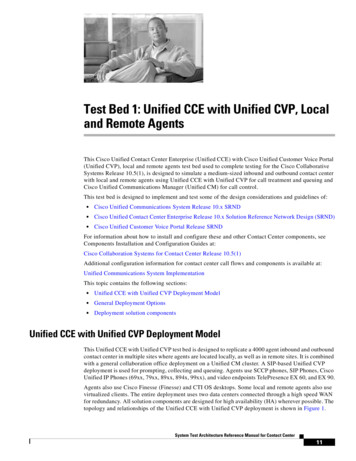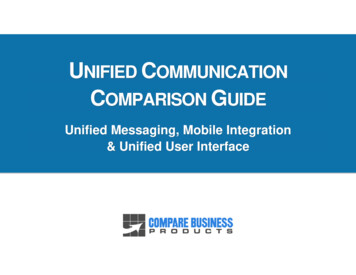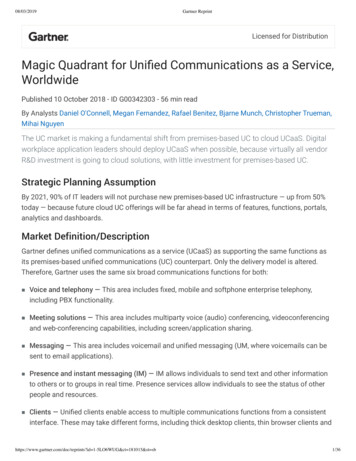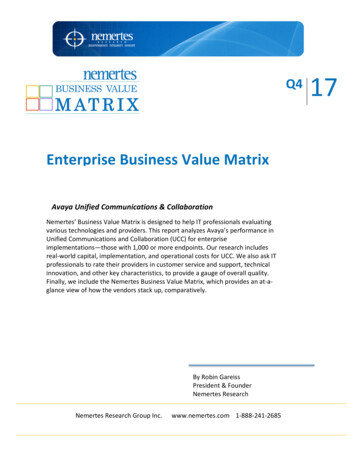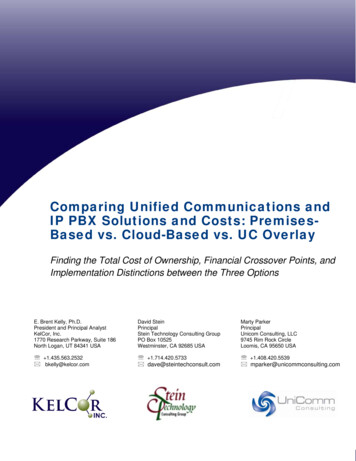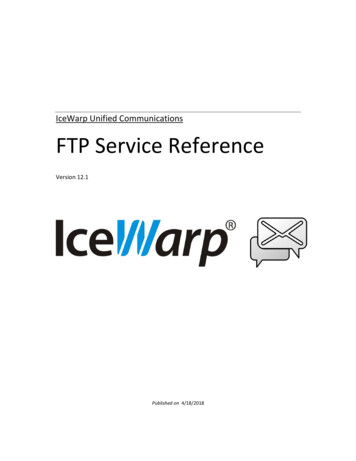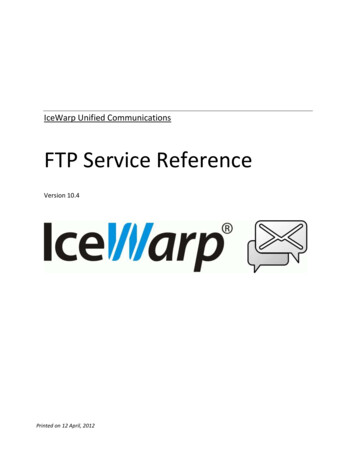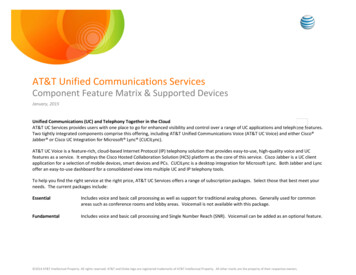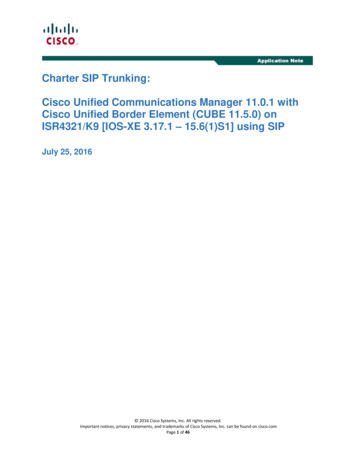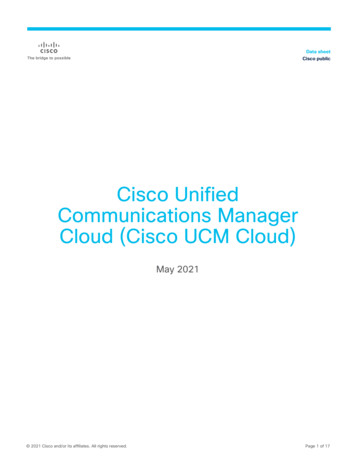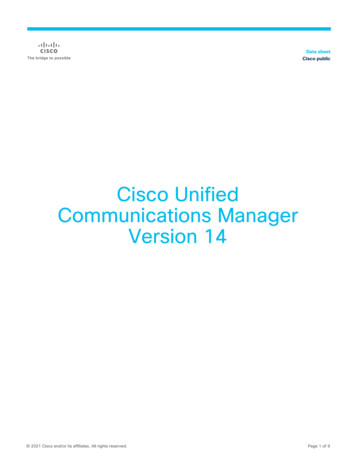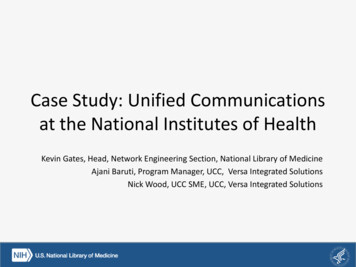
Transcription
Case Study: Unified Communicationsat the National Institutes of HealthKevin Gates, Head, Network Engineering Section, National Library of MedicineAjani Baruti, Program Manager, UCC, Versa Integrated SolutionsNick Wood, UCC SME, UCC, Versa Integrated Solutions
Background, about NIH The world’s largest biomedical research agency– Comprised of 27 Institutes and Centers (IC’s) including the National LibraryMedicine (NLM)– Supports the research of more than 2,500 universities and researchinstitutions– 6,000 scientists work in NIH’s own research laboratories– 300,000 people across the country and around the world workingtogether to prevent disease and improve healthTelecommunications infrastructure provides 24-hour telephone/networkservice and the ability for the collaboration of scientific research– ISDN telephone system for voice service to 40,000 on/off campus users– VideoCast/Podcast to provide real-time video/audio streaming forseminars, conference or live meetings to world-wide audiences over theInternet
Providing a campus solution using MSand Cisco NIH is embarking on a multi-year initiative to take advantage of the UCCcapabilities and cost saving potential Flexible enough to support 27 IC’s (approximately 40,000 users) withvarying needs and preferences– Microsoft Lync is a part of the standard desktop rollout– Some IC’s had a preference for Cisco products Design and Engineer an enterprise solution that supports bothpreferences––––Microsoft (Lync/Polycom Phone)Cisco (Jabber/Cisco Phone)Hybrid (Lync/Cisco Phone)Softphone only use
Why move to Unified CommunicationsCollaboration (UCC)? UCC integrates voice, video, voicemail, email, fax capabilitiesProvides ability for instant messaging, presence, desktop sharing and video/audio and provide capabilities with any device, anywhere and anytime.Cost Savings– Reduction in Equipment– Travel/Telework– Redirect Staff Ease in collaboration with the use of desk phone, laptop, and/or mobile device–––––HD Quality Voice/Video, person-to-person conferencingMessaging: email, fax, voicemailPresence: ability see a person’s availabilityDesktop Sharing: ability to share and edit documents in real-time; whiteboardingMulti-Party Web Conferencing: ability to instantly host meetings with people around theworld, in full HD video and audio, with the touch of a button
Design, Implementation, and Challengesfaced in a multi-vendor environment Complex environment– Cisco, Microsoft both intend to be a standaloneimplementation– Integration complexity Increase infrastructure cost Qualified engineers difficult to find Challenging O&M issues and costs
UCC Deployment ModelsCisco Desk PhonePolycom Desk PhoneCisco Desk PhoneCisco Jabber SoftPhoneMicrosoft Lync SoftPhoneMicrosoft Lync SoftPhoneCisco Unity VoicemailMicrosoft UnifiedMessaging VoicemailMicrosoft UnifiedMessaging Voicemail
StrengthsWeaknessSWOTOpportunitiesThreats
No missed call notifications as an email with thecurrent version. Features available now on newversion. Upgrade awaited. Additional training required for IC’s since usersare already using Lync.Third Party Interoperability apart from all native integration within More expensive endpoints than Polycom. No third party dependency for supportEnterprise license Agreement or ELA Interoperability with Microsoft Tools needadditional configuration. Gartner leader for Corportate telephony and conferencing solutionsfor 2014,2015 New product roll outs and unified monitoringsolutions such as Prime Assurance and Analytics. Increased focus on cloud solutions Reachability to Advanced Resources from Cisco fordeployment and auditing. End-to-End Product Portfolio which integrates well. Unified Solution and Unified Management, CUCM centralized callcontrol. Superior features for audio, video &web conferences Linux Based Architecture, proven higher OS stability. Dependency on SingleVendor/Platform
Microsoft Lync already deployed across NIH. Best use case when no desk phones required.ELA exists with Microsoft Polycom phones are cheaper 100-200 thanCiscoInherent reporting Capabilities. Windows Based Architecture, limited troubleshooting Polycom Deskphones do not have unified managementand have less features and average user experience vsCisco Dependency on Microsoft AD user existenceNO Unified Solution and centralized Management IC’s are already adjusted to Lync Client so nonew training is required.NO End-to-End Product PortfolioThird party (Polycom) Dependency for supportNo Video possible between Lync Client and PolycomPhoneOff-net or Non Lync to Lync call, still dependent on CiscoCall manager for call control even though invisible fromuser experience. Rebranded as Skype for Business, increasedfocus on Microsoft cloud too. Increased focus on inherent capability foranalytics with Skype for BusinessPolycom and Microsoft interoperabilitychanges Since Cisco is part of call control for alloff net calls, Interworking with Cisco.
Cisco Deskphones can be managed centrally withoutloss of telephony feature.Better user Experience of Cisco Phones vs PolycomNo New deployment required for Lync soft phones(Lync already deployed for users)Cost Effective, since Lync is already deployed.IC’s are already adjusted to Lync Client so no newtraining is required. No Message Waiting Indicator on Cisco PhonesMissed call notifications appear when you answer a callon your Cisco IP phone, a Lync notification says youmissed a call, Manual MitigationPresence between the Cisco IP phone and Lync desktopclient does not update on Lync when you are on a callCisco phone will not ring if incoming call is from a Lyncclient, Manual Mitigation by disabling reverse numberlookup. Call control is still not centralized and dependencyexists on multiple infrastructure components . Distributed ManagementComplexity in troubleshooting with multi vendor product support. Multi-vendor deployment gives flexibility to adoptinnovations and new features being introduced byeither vendor. New technology adoption andmigration between solutions can be easier, ratherthan re-deploymentInteroperability Roadblocks in future
NLM’s Customer Perspective on UCCNIH Implementation About the National Library of Medicine, MEECmember, and one of 27 Institutes/Centers atthe NIH– Established in 1836 as the “Library of the Office ofthe Surgeon General of the Army”– It is the world's largest biomedical library and thedeveloper of electronic information services thatdeliver trillions of bytes of data to millions of usersevery day.– Consists of approximately 1,800 Staff
Project Planning, coordination withthe service provider Microsoft Lync (Skype for Business) vs. CiscoJabber– The Pilot– Selection– Leveraging MEEC MS Licensing Preparation–––––Selling project to leadership, gaining supportCollecting information from division/departmentsHardware procurementsProject collaboration with service providerSmall test deployments
NLM Pilot Survey Results
End-User Implementation and lessonslearned User awareness and selling the change– Provide demonstrations– Identify benefits and features for new functionality– Early adopters Deploying hardware– In place before voice activation– Opportunity to train and promote Broadcast message– Include information valuable to users, make themexcited about this ”new” technology– Include “did you know” and other feature benefits
End-User Implementation and lessonslearned Activation– Be available and visible– Provide guidance and test with users Training– End-user Features and Solution Training Soft Clients (MS Lync and Cisco Jabber) Phones (Cisco and Polycom) Phone Features– Administrators and Specialists (Train the Trainers) Follow-up Provide continuous feedback with the service provider––––Any unresolved issues, new issuesChanges in the deployment lineupConduct pre-deployment meetingsReview any post deployment challenges and address them.
Panel Q&A
Polycom Deskphones do not have unified management and have less features and average user experience vs Cisco Third party (Polycom) Dependency for support No Video possible between Lync Client and Polycom Phone Off-net or Non Lync to Lync call, still dependent on Cisco Call manager for call control even though invisible from user .
